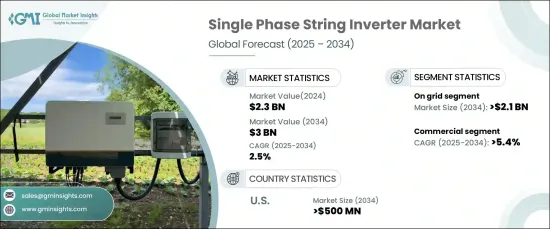 |
市場調查報告書
商品編碼
1665368
單相串式逆變器市場機會、成長動力、產業趨勢分析及 2025 - 2034 年預測Single Phase String Inverter Market Opportunity, Growth Drivers, Industry Trend Analysis, and Forecast 2025 - 2034 |
||||||
2024 年全球單相串式逆變器市場價值為 23 億美元,預計 2025 年至 2034 年期間將以 2.5% 的複合年成長率穩步成長。它們的主要功能是將太陽能電池板產生的直流電(DC)轉換為交流電(AC),使其與單相電網相容。

人們對永續性和能源獨立的認知不斷增強,這是推動太陽能應用的主要驅動力,從而推動了對單相串式逆變器的需求。隨著人們對氣候變遷的擔憂加劇,向再生能源的轉變勢頭強勁,尤其是在住宅領域。這種轉變,加上太陽能技術的快速進步,正在推動市場成長並鼓勵這些高效能能源系統的廣泛使用。
| 市場範圍 | |
|---|---|
| 起始年份 | 2024 |
| 預測年份 | 2025-2034 |
| 起始值 | 23億美元 |
| 預測值 | 30億美元 |
| 複合年成長率 | 2.5% |
按連接性進行市場細分錶明,市場主要關注併網系統,預計到 2034 年將產生 23 億美元的市場規模。這些系統與公用電網無縫整合,使用戶能夠透過淨計量計劃將多餘的能源賣回給電網,從而降低電力成本並提高可負擔性。降低碳排放和減少對化石燃料的依賴的力度不斷加大,推動了併網太陽能解決方案的採用。
市場進一步按應用分類,其中住宅和商業領域顯示出強勁的成長潛力。特別是商業領域,預計到 2034 年將以令人印象深刻的 5.5% 的複合年成長率成長,這得益於其針對中小型企業的可擴展性和成本效率。單相串式逆變器提供出色的投資報酬率 (ROI),並可根據不斷變化的業務需求靈活地擴大能源生產規模。此外,緊湊、高效的空間設計解決了商業空間的安裝難題,增強了產品的吸引力和採用率。
在美國,單相串式逆變器市場預計到 2034 年將達到 5.5 億美元。人們對電網不穩定、停電和極端天氣事件的擔憂日益加劇,促使企業優先考慮能源彈性和安全性。隨著企業尋求永續、經濟高效的解決方案來降低營運費用並增強能源獨立性,市場將實現持續成長。
目錄
第 1 章:方法論與範圍
- 研究設計
- 基礎估算與計算
- 預測模型
- 初步研究與驗證
- 主要來源
- 資料探勘來源
- 市場定義
第 2 章:執行摘要
第 3 章:產業洞察
- 產業生態系統
- 監管格局
- 產業衝擊力
- 成長動力
- 產業陷阱與挑戰
- 成長潛力分析
- 波特的分析
- 供應商的議價能力
- 買家的議價能力
- 新進入者的威脅
- 替代品的威脅
- PESTEL 分析
第4章:競爭格局
- 介紹
- 戰略儀表板
- 創新與技術格局
第5章:市場規模及預測:依連結性,2021 – 2034 年
- 主要趨勢
- 獨立
- 在電網上
第 6 章:市場規模與預測:按應用,2021 – 2034 年
- 主要趨勢
- 住宅
- 商業的
第 7 章:市場規模及預測:按地區,2021 – 2034 年
- 主要趨勢
- 北美洲
- 美國
- 加拿大
- 歐洲
- 德國
- 義大利
- 荷蘭
- 英國
- 法國
- 亞太地區
- 中國
- 澳洲
- 印度
- 日本
- 韓國
- 中東和非洲
- 以色列
- 沙烏地阿拉伯
- 阿拉伯聯合大公國
- 南非
- 拉丁美洲
- 巴西
- 墨西哥
- 智利
第8章:公司簡介
- APsystems
- Canadian Solar
- Enphase Energy
- Fronius International
- Huawei Technologies
- INVTSolar
- NingBo Deye Inverter Technology
- Solaredge Technologies
- SUNGROW
- UTL Solar
The Global Single Phase String Inverter Market, valued at USD 2.3 billion in 2024, is projected to grow at a steady CAGR of 2.5% between 2025 and 2034. These inverters are integral to small and medium-sized photovoltaic systems, predominantly serving residential and small commercial applications. Their primary function is converting direct current (DC) generated by solar panels into alternating current (AC), making it compatible with single-phase electrical grids.

The rising awareness of sustainability and energy independence is a key driver of solar power adoption, fueling the demand for single-phase string inverters. As concerns about climate change intensify, the transition toward renewable energy sources gains momentum, particularly in residential sectors. This shift, combined with rapid advancements in solar technology, is propelling market growth and encouraging the widespread use of these efficient energy systems.
| Market Scope | |
|---|---|
| Start Year | 2024 |
| Forecast Year | 2025-2034 |
| Start Value | $2.3 Billion |
| Forecast Value | $3 Billion |
| CAGR | 2.5% |
Market segmentation by connectivity reveals a significant focus on on-grid systems, which are projected to generate USD 2.3 billion by 2034. On-grid inverters offer substantial cost advantages over their off-grid counterparts, which require expensive battery storage. These systems seamlessly integrate with utility grids, enabling users to sell surplus energy back to the grid through net metering programs, reducing electricity costs and improving affordability. Increasing efforts to lower carbon emissions and reduce reliance on fossil fuels are driving the adoption of grid-connected solar solutions.
The market is further categorized by application, with residential and commercial sectors showing robust growth potential. The commercial segment, in particular, is expected to grow at an impressive CAGR of 5.5% through 2034, bolstered by its scalability and cost efficiency for small to medium-sized businesses. Single-phase string inverters provide an excellent return on investment (ROI) and offer the flexibility to scale energy production in line with evolving business needs. Additionally, compact, space-efficient designs that address installation challenges in commercial spaces are enhancing product appeal and adoption.
In the United States, the single-phase string inverter market is forecasted to reach USD 550 million by 2034. Federal tax credits, state-level rebates, and financial incentives are driving solar photovoltaic installations across the country. Rising concerns over grid instability, power outages, and extreme weather events are prompting businesses to prioritize energy resilience and security. As companies seek sustainable, cost-effective solutions to reduce operational expenses and enhance energy independence, the market is positioned for sustained growth.
Table of Contents
Chapter 1 Methodology & Scope
- 1.1 Research design
- 1.2 Base estimates & calculations
- 1.3 Forecast model
- 1.4 Primary research & validation
- 1.4.1 Primary sources
- 1.4.2 Data mining sources
- 1.5 Market definitions
Chapter 2 Executive Summary
- 2.1 Industry synopsis, 2021 – 2034
Chapter 3 Industry Insights
- 3.1 Industry ecosystem
- 3.2 Regulatory landscape
- 3.3 Industry impact forces
- 3.3.1 Growth drivers
- 3.3.2 Industry pitfalls & challenges
- 3.4 Growth potential analysis
- 3.5 Porter's analysis
- 3.5.1 Bargaining power of suppliers
- 3.5.2 Bargaining power of buyers
- 3.5.3 Threat of new entrants
- 3.5.4 Threat of substitutes
- 3.6 PESTEL analysis
Chapter 4 Competitive landscape, 2024
- 4.1 Introduction
- 4.2 Strategic dashboard
- 4.3 Innovation & technology landscape
Chapter 5 Market Size and Forecast, By Connectivity, 2021 – 2034 (USD Billion & MW)
- 5.1 Key trends
- 5.2 Standalone
- 5.3 On grid
Chapter 6 Market Size and Forecast, By Application, 2021 – 2034 (USD Billion & MW)
- 6.1 Key trends
- 6.2 Residential
- 6.3 Commercial
Chapter 7 Market Size and Forecast, By Region, 2021 – 2034 (USD Billion & MW)
- 7.1 Key trends
- 7.2 North America
- 7.2.1 U.S.
- 7.2.2 Canada
- 7.3 Europe
- 7.3.1 Germany
- 7.3.2 Italy
- 7.3.3 Netherlands
- 7.3.4 UK
- 7.3.5 France
- 7.4 Asia Pacific
- 7.4.1 China
- 7.4.2 Australia
- 7.4.3 India
- 7.4.4 Japan
- 7.4.5 South Korea
- 7.5 Middle East & Africa
- 7.5.1 Israel
- 7.5.2 Saudi Arabia
- 7.5.3 UAE
- 7.5.4 South Africa
- 7.6 Latin America
- 7.6.1 Brazil
- 7.6.2 Mexico
- 7.6.3 Chile
Chapter 8 Company Profiles
- 8.1 APsystems
- 8.2 Canadian Solar
- 8.3 Enphase Energy
- 8.4 Fronius International
- 8.5 Huawei Technologies
- 8.6 INVTSolar
- 8.7 NingBo Deye Inverter Technology
- 8.8 Solaredge Technologies
- 8.9 SUNGROW
- 8.10 UTL Solar












